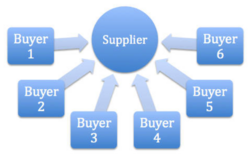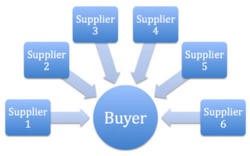Finance:Eauction
An electronic auction (E-Auction or e-auction or eAuction) is an auction conducted over the Internet to negotiate terms of contract between suppliers and buyers.
Definition
The electronic auction (eAuction) is an e-business process between auctioneers and bidders, (which takes place on an electronic marketplace). It works like any auction that is online.
Examples for the different types of e-auction:.[1][2][3]
- Business 2 Business: Product exchange and wholesale quotation
- Business 2 Consumer: Online-Shopping, tourism trip booking, ticket reservation, services in finance and insurance.
- Consumer 2 Consumer: Typically C2C transactions are auctions and file-sharing services. Some examples are ciao.de and e-bay.
Types
The two major types of electronic auction are forward auction in which several buyers bid for one seller's goods, and reverse auction, in which several sellers bid for one buyer's order.
Forward auctions take the form of a single seller offering an item. Buyers compete to secure the item by bidding the price upward. Forward auctions are better understood by the public than reverse auctions, primarily because they are widely used at the consumer level. Forward auctions are widely used for auctioning automobiles, real estate, machinery, etc.. Thus, a forward auction is to be utilized for sales of goods and services of all types, whether conducted online, offline or a hybrid of the two.
Reverse auctions are the other major form of auctions. In a reverse auction, a single buyer makes potential sellers aware of their intent to buy a specified good or service. During the course of the actual reverse auction event, the sellers bid against one another to secure the buyer’s business, driving the price to be paid for the item downward. Thus, the winning bidder is the seller who offers the lowest price. Reverse auctions are most typically used for procurement by private companies, public sector agencies, and non-profit organizations.
There are several types of auctions possible, e.g. Dutch Auction, English Auction, and Japanese Auction.
Context
The auction itself follows clearly defined rules which are obeyed by all market participants. This is similar to any usual auction, as the basic principles remain the same.
With B2B markets in the industrial sector, an e-auction first requires a detailed description from the purchaser before suppliers can respond. Factors that directly act on the bidding include the specific bid amount, the historical price, the target price, the step size for the variation of the bidding and the extension of the auction period through the waiting period. The historical price marks the price threshold, which should not be exceeded. The target price is relevant for the contractually fixed surplus. It is the price threshold that bound the purchaser to order within the appointed deadline. After this tender process, there is a negotiation that allows flexible pricing and competition. Mostly E-Auctions are Reverse Auctions, where the sellers compete to obtain business from the buyer and prices will typically decrease as the sellers undercut each other.
At the end of the auction, the waiting period is the time the auction will go on if there is a new bid. The duration of the waiting period influences E-Auction, as suppliers fear to lose the order to a competitor.
After the negotiation process, the E-Auction takes place in a specific period of time, starting from this moment the bidders (=supplier) have the possibility to submit their bids (=price) for the items over the internet. All bids are public domain for the participants of the E-Auction. Based on the detailed description of the requirements, the target price is calculated. When the time of the E-Auction is over, the lowest bid (=price) gets the acceptance of the tender (Reverse Auction). The demander’s contract terms set the frame for the whole process.[4]
After that, a mandatory contract is made. The purchaser is indentured to accept the good and pay the price while the seller is indentured to deliver the good.
Strengths and limitations
There are many components to a successful eAuction, including good strategies, best practices, and ethics.[5]
Limitations include:
- Possibility of fraud
- Limited participation
- Security
- Auction software
- Long cycle time
- Monitoring time
- Equipment for buyers
- Order fulfillment costs
References
- ↑ Kleusberg, Peter (2009). E-Collaboration und E-Reverse Auctions. Saarbrücken. pp. 16–25.
- ↑ Engelbrecht-Wiggans, Peter (2006). E-Sourcing in Procurement. Management Science. p. 581.
- ↑ Wyld, David C. (2012). REVERSE AUCTIONS 101. Louisiana: Southeastern Louisiana University.
- ↑ Göpfert, I. (2005). Logistic Stories. München: Froschmayer. pp. 257–277.
- ↑ "Beispiele für B2B,B2C,C2C". http://www.itwissen.info/definition/lexikon/E-Auction-eAuction-electronic-auction.html.



